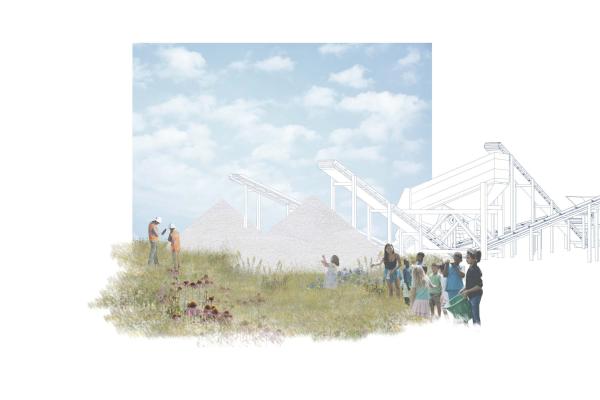Texas Landscape Project Selected to Represent Nationwide Green New Deal Superstudio Initiative

The Green New Deal Superstudio was an open call and nationwide conversation about how the framework of the Green New Deal could be translated into design and planning projects. The initiative brought 3,000 designers and students together from across the country to explore decarbonization, jobs, and justice from a designer’s perspective and to give form to what this movement-led vision could mean for the future.
Of the 670 submissions from over 90 universities, a curated set of 55 projects were selected to serve as a representative sample of the Green New Deal Superstudio initiative. And a project developed by Texas Landscape graduate Kristin Witte (MLA ’21), “Rooted Rubble: Community Resourcing Through a Material and Prairie Connection,” was one of them! Completed as part of Assistant Professor Maggie Hansen’s Spring 2021 Advanced Studio “Prairie Time: Growing Dallas’ Green Quilt,” “Rooted Rubble” investigates West Dallas and its history of material extraction for cement manufacturing.
Working in dialogue with Dallas-based designers, Gwen Cohen and Isaac Cohen of Studio Outside, the studio speculated on the potential of centering human actions of caretaking, alongside the dynamics of landscape materials and site, toward more just and ecological futures. Throughout the semester, students learned about the relationships of the Blackland Prairie and its significance in Dallas’ history and future, through guest lectures by experts from a range of disciplines. Restoration ecologist, Brandon Belcher described the ecological processes and structure of the prairie and his work at Clymer Meadow. Dr. Mariah Wade, Associate Professor of Anthropology at UT-Austin, introduced the class to the prehistoric and early Native American relationships with the prairie in Texas. Dr. Kathryn Holliday, Associate Professor and architectural historian at UT-Arlington, spoke on Dallas’ planning history and the city’s relationship to the Trinity River and prairie soil. Students also learned about current efforts to address a legacy of industrial contamination from Evelyn Mayo, at Downwinders at Risk, and art-based explorations of the prairie by Tamara Johnson and Trey Burns, cofounders of Sweet Pass Sculpture Park. With this background and their own design explorations, students developed specific proposals for re-activating fallow lands in Dallas, building on the potential benefits and management of the Backland Prairie.
In this context, Witte’s proposal looks at the physical infrastructure of North and South Dallas, made from the labor of communities that are no longer supported by heavy industries like material extraction for cement manufacturing. Here, industry is zoned next to residences, schools, and important resources for the surrounding community. These inappropriate adjacencies have consequences for human health and have created a lack of neighborhood connection. Witte explored the potential of a “justice zoning overlay” to support remediation in districts with a history of heavy industry and to encourage changes in land use that prioritizes the well-being of residents.
Cement and concrete manufacturing are also one of the top carbon polluters, at an estimated 7% of global carbon emissions. Concrete can permanently store carbon, through a process known as carbonization; and by intervening in its manufacturing process, a close-looped system of recycling and reuse, it can begin to capture a portion of the carbon emissions released in its production. Introducing a green industry to this area would supply more jobs than landfill and incinerator jobs while repurposing a ‘waste’ material. Interventions that utilize recycled concrete create a material legibility that can be seen and experienced throughout the neighborhood.
Witte’s proposal also reintroduces a Blackland Prairie ecology, an eco-region native to the area yet not intact due to a history of mass crop production and urbanization. Tall grass species are quick to establish, with remediating qualities that remove carbon and pollutants from air, water, and soil. Ideas of progress have been made at the expense of land and, often, the residing peoples. This project utilizes a lost ecology and repurposes an exploitative material in order to reclaim and create investments in community health and livelihood.
The Green New Deal Superstudio is a joint initiative of the Landscape Architecture Foundation (LAF) in association with the Weitzman School of Design McHarg Center, the Center for Resilient Cities and Landscapes, the American Society of Landscape Architects, and the Council of Educators in Landscape Architecture. For more information about the Green New Deal Superstudio and to check out the 670 projects submitted as part of the initiative, visit: https://www.gndsuperstudio.com/

